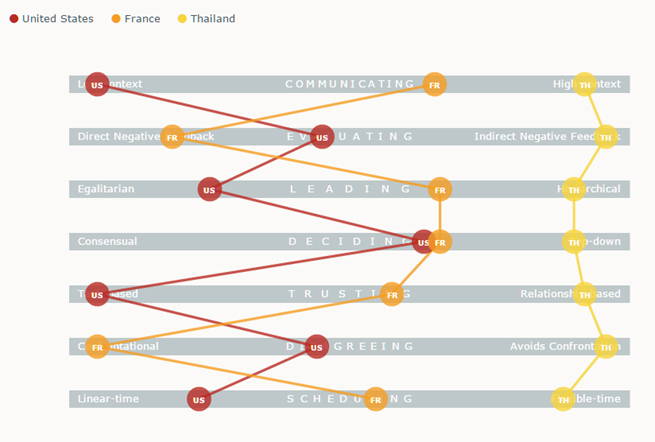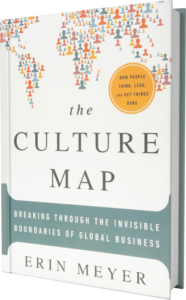This book has been recommended to me by my dear friend Eitan. During a casual sunset drink in Lisbon last year, we were talking about the different ways or even personalities to adopt when talking to different colleagues, Israeli, Japanese or Brazilians.
Eitan was apologising for the bluntness of the people of his culture, I was apologising for all the complaining that French people do. And we were both commenting about the office culture when we met in Japan, years ago.
Then, Eitan started to open my mind to the various dimensions of cultures there are in the communication world and how they affect people relationships which he had read in this book that he recommended to me.
Enters the Culture Map by Erin Meyer. Erin Meyer is an American professor teaching a business school in France, more on this later. Across various studies and examples, Erin Meyer has been able to draw a map of culture characteristics and how they differ from one culture to the other.
You should read this book if you are dealing on a daily basis in international waters. As I mentioned in the introduction, you cannot talk the same way to Israeli and Brazilian colleagues and expect the same reactions nor results. Across my career, I have noticed from France to Japan that there were immense hidden lakes of unwritten rules and part of the international experience is to learn to identify them and navigate them the best way possible. Later, as a French person in Portugal and then Brazil, even though I though I wasn’t in troubled water anymore, there were also funky misunderstanding and confusing shocks.
Now that I am dealing with customers for all Latin America, unfortunately I don’t have the time to learn each culture differences compared to what is left of my drowning French civilisation. And I wish somebody could help me.
Everybody knows about the culture traps, but everybody will also fall into them too.
Erin Meyer has devised an 8-scale cultural map. All scales of the maps go on a line between 2 attitude values, and all countries cultures fall in between. What is important is not the exact position of the country on the line, but its relativeness compared to others. France is more like this than UK, but less than Russia.
In the end, the map looks like zig zags:
Let’s get a bit more into details of the scales. The first few ones are really interesting and deeper than the last ones, which I found easier to apprehend.
Context
Some culture are high context (Japan), some low (USA). It means when you are talking to people, in higher context culture, you have to take into account… the context. It tends to relate the country history. In lower context, everything is and has to be more explicit.
If you need to communicate into a higher context culture from a lower context culture, read the air and try to understand what is meant instead of what is said.
To lower context culture from higher: show you cards upfront, question yourself on all you statement to make yourself as clear as possible.
From higher to higher, beware of the minefield.
Negative Feedback
This one is quite straightforward, some cultures give negative feedback bluntly in your face, other cultures hide, delay or avoir giving negative feedback. Be kind.
Persuading
Some culture reason with theory first (principle) and some with application, more tangible. Principle first creates a theory from what is already known. See syllogism. Application first draws its conclusions from observation.
To convince people of something, understand what was their cultural background and education system, and then adapt to them: show theory or application accordingly.
Leading
Easy. Egalitarian versus hierarchical. A very interesting idea of the power distance (ref Hofstede) is described in this chapter which explains how people are reacting to power distribution.
Decision
Consensual versus top down. To my surprise leading structure (previous chapter) can be different from decision making structure. Japan has a hierarchical society but very egalitarian on the decision making. See Ringi system. I have lived there for 4 years and I just had an epiphany reading about this.
Also in this chapter, there is an anecdote that I could relate 1000%: the little d versus the big D (d being for decision, duh). When working with US customers, it’s always little d: the decision are made to get some work done, progress and maybe… change! It got me crazy so many times, because I was used to the big D: decision is made and there should not be any change after. Bam, second epiphany.
Trusting
Trust is developed task based or relationship based depending on the culture. That’s why in Japan, all contracts are signed in bars around drinks, unofficially. I already knew this as I have signed soooo many contracts.
Confrontation
You can disagree and say it, or avoir confrontation. There is another nuance to it: emotional expressiveness. German will coldly disagree. Philippines warmly avoid confrontation. French will disagree all the time. hehe.
Time management
It has to do historically with the predictability and dynamism of a culture environment. In industrialised countries, you can count on things to work as they are supposed to, so people expect more punctuality.
So certain cultures are more punctual than others. How many meeting in Brazil started at least 15 minutes late? Get used to it, don’t get offended.
—
I really liked the book. It allowed me to put words and concepts where I was clearly missing them. In some parts, like the decision making or the negative feedback, it was even eye opening. Reading the explanation in simple words was liberating. Yes, finally, I could understand what had happened to me at various points of my career in various places.
A negative feedback though… (of course)
At the end of the book, I was expecting some kind of gigantic summary, the big culture map of most countries of the world. I would be able to compare my culture with various countries of Latin America at a glance. Super quickly. Like a easy to access memo or a folded poster
But, no, no such thing at the end of the book.
I was disappointed. After a quick googling, I understood why: the author is offering a paying tool to get access to the updated data of the culture map. This hurt. As if the book was just an expensive advertisement for the “latest data”. And you can even get a subscription. Oh, please die with all your subscription models.
Now, comes the direct-confrontation-but-after-we-will-still-be-friends (of course again). Thinking about it… What would you expect from a book from a person working in a French business school? Always lots of teasing but always failing to deliver anything completely satisfying.
“Nothing, people or ideas, coming out of a French business school, is ever truly decent.”
Victor Hugo [1]not it’s not
Jokes aside, read this book.
- Self Aware On Air Neon Sign - 8 June 2024
- La Commune : review - 30 March 2024
- Fearless Dinosaur - 12 March 2024
References
| ↑1 | not it’s not |
|---|


